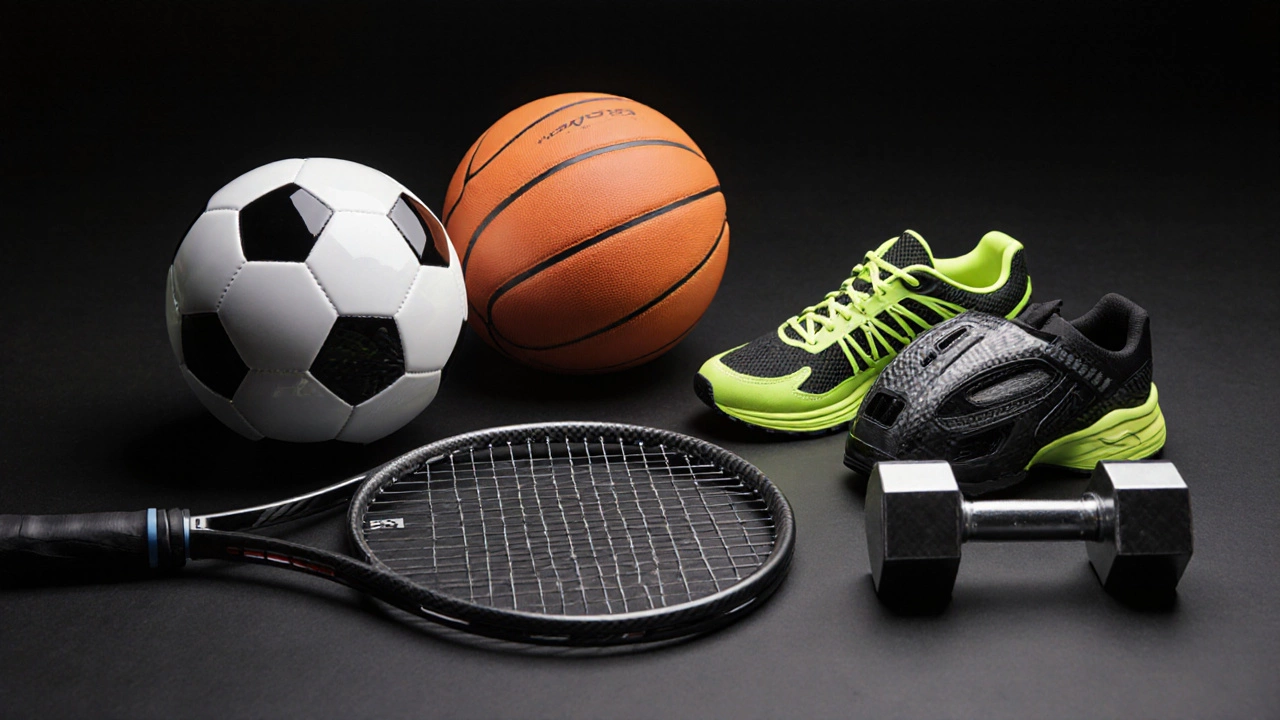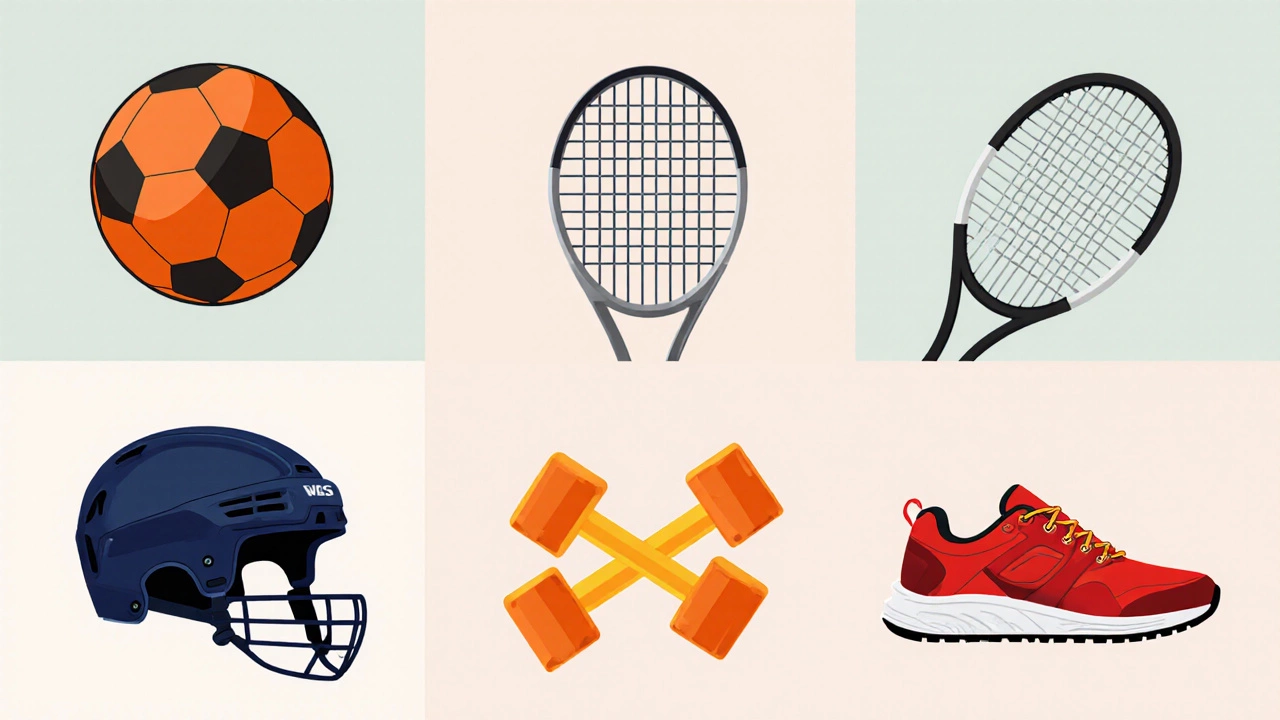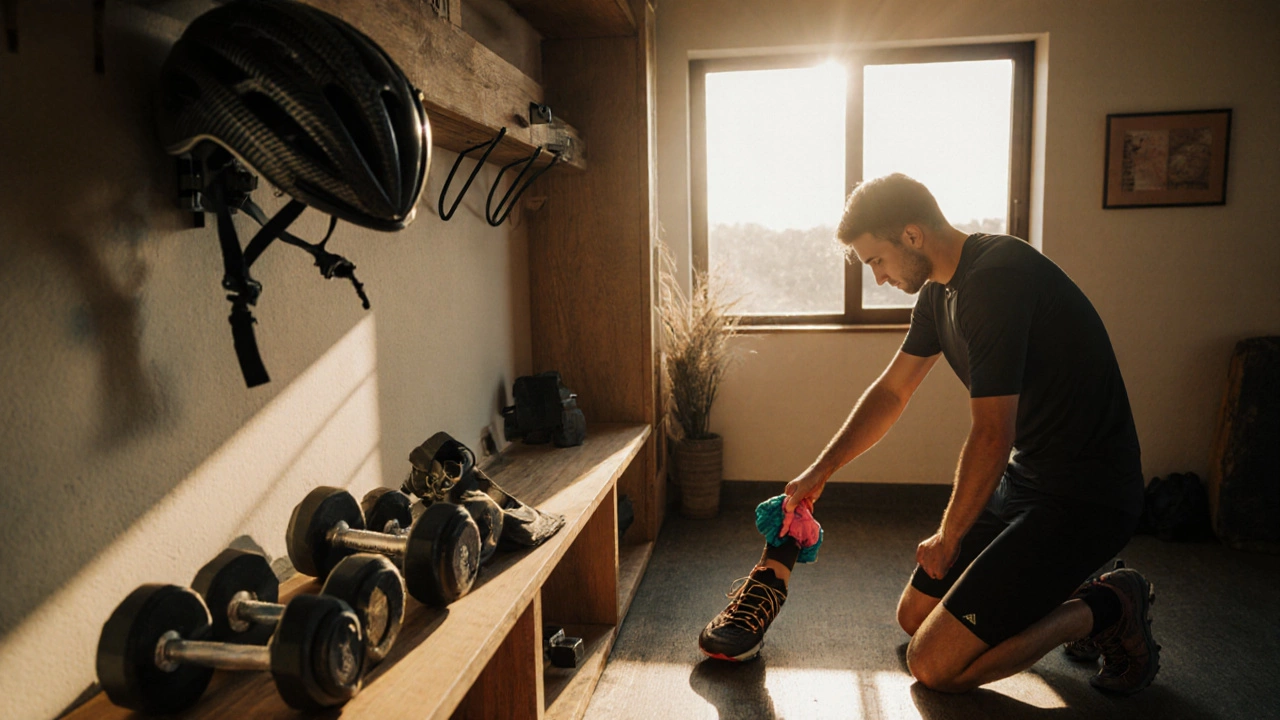Examples of Sports Equipment - A Complete Guide
 Oct, 24 2025
Oct, 24 2025
Sports Equipment Selector
Select Your Sport
Select your sport and skill level to see recommendations
When you hear the term sports equipment is any tool, apparel, or accessory used to participate in a physical activity or competition, you might picture a football or a pair of running shoes. But the world of sports gear is far broader - from the tiny dumbbell you lift at home to the high‑tech helmet that protects a cyclist on a mountain trail. This guide walks you through concrete examples across dozens of activities, helping you spot what you need, why it matters, and how to keep it in top shape.
Why knowing the right gear matters
Choosing the proper equipment isn’t just about looking cool on the field. The right gear can boost performance, reduce injury risk, and prolong your enjoyment of the sport. A well‑fitted helmet protective headwear designed to absorb impact can mean the difference between a minor bump and a serious concussion. Similarly, the correct footwear shoes engineered for specific movement patterns and surfaces can improve balance, enhance speed, and prevent joint strain.
Categories of sports equipment
Broadly, sports gear falls into five groups: balls & projectiles, striking tools, protective gear, apparel & footwear, and training accessories. Below is a quick snapshot of each category, the sports they serve, and a typical example.
| Category | Typical Sports | Example Item |
|---|---|---|
| Ball & Projectile | Soccer, Basketball, Golf | Soccer ball |
| Striking Tool | Tennis, Badminton, Table Tennis | Tennis racket |
| Protective Gear | Boxing, Hockey, Cycling | Boxing gloves |
| Apparel & Footwear | Running, Football, Hiking | Trail running shoes |
| Training Accessories | Cross‑fit, Home gyms, Rehab | Adjustable dumbbells |
Examples of equipment by sport
Below is a curated list of concrete gear you’ll encounter in popular sports. Each entry includes a brief description to clarify its purpose.
- Ball - The universal projectile. Varieties include a soccer ball size‑5, stitched leather or synthetic cover for outdoor play, a basketball official 29.5‑inch circumference, leather or composite material, and a golf ball dimples designed for aerodynamic lift and controlled spin.
- Racket - Used in tennis, badminton, and squash. A tennis racket graphite frame with a 100‑square‑inch strung area for power and control differs from a badminton racket lightweight carbon‑fiber shaft and a 22‑inch head for quick maneuverability.
- Helmet - Critical for head protection. In cycling, a road bike helmet aerodynamic shell with EPS foam liner and ventilation channels offers lightweight coverage, while a hockey helmet polycarbonate shell with a metal cage for face protection meets stricter impact standards.
- Protective gear - Beyond helmets, many sports demand body armor. boxing gloves padded leather gloves designed to cushion punches and protect hands are a staple in combat sports, while shin guards hard‑plastic shells for soccer and field hockey shield lower legs from impact.
- Footwear - Specialized shoes boost performance. trail running shoes rugged outsole with aggressive lugs for uneven terrain differ from football cleats metal or molded studs for traction on grass, and from basketball sneakers high‑top design for ankle support on hardwood courts.
- Training accessories - Tools to improve strength, flexibility, and skill. adjustable dumbbells weight plates selectable from 5 lb to 50 lb for home gyms let you progress gradually. resistance bands elastic loops offering variable tension for rehab and conditioning are portable and versatile.
- Swimming gear - Essential for aquatic sports. A performance swimsuit hydrodynamic fabric that reduces drag in competitive swimming pairs with a goggles anti‑fog lenses that seal around the eyes for clear underwater vision. swim cap silicone or latex cover to streamline hair and protect ears completes the kit.
- Cycling gear - More than a bike. A cycling jersey breathable polyester with rear pockets for snacks and tools works with cycling shorts padded chamois to reduce saddle soreness on long rides. Clipless pedals and compatible shoes form a secure power transfer system.
- Fitness trackers - Wearable tech that monitors activity. A fitness tracker wrist‑worn device that records heart rate, steps, and sleep patterns can guide training intensity and recovery.

Choosing the right equipment
Here are practical steps to make sure you buy the best gear for your needs:
- Identify the primary sport and its specific demands (speed, impact, endurance).
- Set a budget and look for reputable brands that meet safety certifications (e.g., ASTM for helmets).
- Try the equipment when possible - the fit of footwear or the feel of a racket can vary widely.
- Read reviews that focus on durability and real‑world performance, not just marketing hype.
- Consider multipurpose items if you practice several sports; a quality pair of cross‑training shoes can serve running, gym, and light court work.
Maintenance and safety tips
Even the best gear loses its edge if you neglect it. Follow these simple habits:
- Clean after each use. Rinse swimming gear with fresh water, wipe down basketballs, and wipe sweat from gloves.
- Inspect for wear. Look for cracks in helmets, frayed laces on shoes, or loss of air in inflatable balls.
- Store properly. Keep rackets in a humid‑controlled case, hang helmets on a rack, and store dumbbells on a flat surface.
- Replace when needed. A damaged pair of cycling gloves can cause blisters; a worn‑out tennis racket string loses tension and accuracy.

Quick reference checklist
Copy this list to your phone or notebook before you head to the store:
- Sport & specific activity
- Core equipment (ball, racket, etc.)
- Protective gear (helmet, pads)
- Footwear type
- Training accessories you’ll need for warm‑up or conditioning
- Maintenance routine (clean, inspect, store)
Frequently Asked Questions
What qualifies as sports equipment?
Any tool, apparel, or accessory specifically designed to enable, enhance, or protect an athlete while performing a physical activity counts as sports equipment.
Do I need a separate helmet for each sport?
Not always. A multi‑sport helmet that meets safety standards for cycling, skateboarding, and inline skating can work for several activities, but sports like football or snowboarding require sport‑specific helmets to meet impact criteria.
How often should I replace my running shoes?
Most experts recommend swapping out shoes after 300‑500 miles (roughly 480‑800 km) or when you notice uneven wear on the outsole, reduced cushioning, or ankle discomfort.
Can I use the same resistance bands for rehab and high‑intensity training?
Yes, as long as the band’s tensile strength matches the demand. Light‑resistance bands are ideal for rehab, while heavy‑resistance bands (≥200 lb) handle intense strength work.
What’s the best way to clean a tennis racket?
Wipe the frame with a damp cloth after each session, avoid submerging it in water, and clean the strings with a soft brush to remove sweat and debris.